Response of Ecosystem Health to Land Use Changes and Landscape Patterns in the Karst Mountainous Regions of Southwest China
Abstract
:1. Introduction
2. Materials and Methods
2.1. Study Area
2.2. Data Source and Data Processing
2.3. Assessment Framework of Ecosystem Health
2.3.1. Ecosystem Vigor (V)
2.3.2. Ecosystem Organization (O)
= (0.4769 × SHDI + 0.2384 × SHEI) + (0.0255 × COHESION + 0.1169 × CONTAG + 0.0446 × DIVISION) + (0.0814 × AWMFDI + 0.0163 × MNPARA)
2.3.3. Ecosystem Resilience (R)
2.3.4. Normalization and Classification of Ecosystem Health (EH)
2.4. Comprehensive Analysis of Landscape Patterns and Changes in EH
2.4.1. Impact of Land Use Landscape Changes on EH
2.4.2. Impact of Landscape Composition and Configuration on EH
3. Results
3.1. Land Use Dynamics from 2008 to 2017
3.2. Changes in EH from 2008 to 2017
3.3. Relationship between Landscape Types Change and Ecosystem Health
3.4. Influence of Landscape Composition and Configuration on Ecosystem Health
4. Discussion
4.1. Response of Ecosystem Health to Land Use Changes
4.2. Relationship between Landscape Structure and Ecosystem Health
4.3. Limitations and Future Work
5. Conclusions
Author Contributions
Funding
Institutional Review Board Statement
Informed Consent Statement
Data Availability Statement
Acknowledgments
Conflicts of Interest
References
- Peng, J.; Liu, Y.; Li, T.; Wu, J. Regional ecosystem health response to rural land use change: A case study in Lijiang City, China. Ecol. Indic. 2017, 72, 399–410. [Google Scholar] [CrossRef]
- Peng, J.; Liu, Y.; Wu, J.; Lv, H.; Hu, X. Linking ecosystem services and landscape patterns to assess urban ecosystem health: A case study in Shenzhen City, China. Landsc. Urban Plan. 2015, 143, 56–68. [Google Scholar] [CrossRef]
- Rapport, D.J.; Maffi, L. Eco-cultural health, global health, and sustainability. Ecol. Res. 2011, 26, 1039–1049. [Google Scholar] [CrossRef]
- Rapport, D.J. What constitutes ecosystem health? Perspect. Biol. Med. 1989, 33, 120–132. [Google Scholar] [CrossRef]
- Dernbach, J.C.; Mintz, J.A. Environmental laws and sustainability: An introduction. Sustainability 2011, 3, 531–540. [Google Scholar] [CrossRef] [Green Version]
- Peng, J.; Wang, Y.; Wu, J.; Zhang, Y. Evaluation for regional ecosystem health: Methodology and research progress. Acta Ecol. Sin. 2007, 27, 4877–4885. [Google Scholar] [CrossRef]
- Xiao, R.; Liu, Y.; Fei, X.; Yu, W.; Zhang, Z.; Meng, Q. Ecosystem health assessment: A comprehensive and detailed analysis of the case study in coastal metropolitan region, eastern China. Ecol. Indic. 2019, 98, 363–376. [Google Scholar] [CrossRef]
- Pinto, U.; Maheshwari, B.L.; Ollerton, R.L. Analysis of long-term water quality for effective river health monitoring in peri-urban landscapes—A case study of the Hawkesbury–Nepean river system in NSW, Australia. Environ. Monit. Assess. 2013, 185, 4551–4569. [Google Scholar] [CrossRef]
- Yu, G.; Yu, Q.; Hu, L.; Zhang, S.; Fu, T.; Zhou, X.; He, X.; Liu, Y.A.; Wang, S.; Jia, H. Ecosystem health assessment based on analysis of a land use database. Appl. Geogr. 2013, 44, 154–164. [Google Scholar] [CrossRef]
- Costanza, R. Ecosystem health and ecological engineering. Ecol. Eng. 2012, 45, 24–29. [Google Scholar] [CrossRef] [Green Version]
- Das, M.; Das, A.; Pereira, P.; Mandal, A. Exploring the spatio-temporal dynamics of ecosystem health: A study on a rapidly urbanizing metropolitan area of Lower Gangetic Plain, India. Ecol. Indic. 2021, 125, 107584. [Google Scholar] [CrossRef]
- Rapport, D.J.; Regier, H.A.; Hutchinson, T.C. Ecosystem behavior under stress. Am. Nat. 1985, 125, 617–640. [Google Scholar] [CrossRef]
- Costanza, R. Toward an operational definition of ecosystem health. In Ecosystem Health: New Goals for Environmental Management; Costanza, R., Norton, B.G., Haskell, B.D., Eds.; Island Press: Washington, DC, USA, 1992; pp. 239–256. [Google Scholar]
- Lancaster, J. The ridiculous notion of assessing ecological health and identifying the useful concepts underneath. Hum. Ecol. Risk. Assess. 2000, 6, 213–222. [Google Scholar] [CrossRef]
- Rapport, D.J.; Costanza, R.; McMichael, A.J. Assessing ecosystem health. Trends Ecol. Evol. 1998, 13, 397–402. [Google Scholar] [CrossRef]
- Myneni, R.B.; Asrar, G.; Hall, F.G. A three-dimensional radiative transfer method for optical remote sensing of vegetated land surfaces. Remote Sens. Environ. 1992, 41, 105–121. [Google Scholar] [CrossRef]
- Sun, T.; Lin, W.; Chen, G.; Guo, P.; Zeng, Y. Wetland ecosystem health assessment through integrating remote sensing and inventory data with an assessment model for the Hangzhou Bay, China. Sci. Total. Environ. 2016, 566–567, 627–640. [Google Scholar] [CrossRef]
- Liao, C.; Yue, Y.; Wang, K.; Fensholt, R.; Tong, X.; Brandt, M. Ecological restoration enhances ecosystem health in the karst regions of southwest China. Ecol. Indic. 2018, 90, 416–425. [Google Scholar] [CrossRef]
- Wang, Z.; Tang, L.; Qiu, Q.; Chen, H.; Wu, T.; Shao, G. Assessment of Regional Ecosystem Health: A Case Study of the Golden Triangle of Southern Fujian Province, China. Int. J. Environ. Res. Public Health 2018, 15, 802. [Google Scholar] [CrossRef] [Green Version]
- Shen, W.; Zheng, Z.; Qin, Y.; Li, Y. Spatiotemporal Characteristics and Driving Force of Ecosystem Health in an Important Ecological Function Region in China. Int. J. Environ. Res. Public Health 2020, 17, 5075. [Google Scholar] [CrossRef]
- Zhang, F.; Zhang, J.; Wu, R.; Ma, Q.; Yang, J. Ecosystem health assessment based on DPSIRM framework and health distance model in Nansi Lake, China. Stoch. Environ. Res. Risk Assess. 2016, 30, 1235–1247. [Google Scholar] [CrossRef]
- Zeng, C.; Deng, X.; Xu, S.; Wang, Y.; Cui, J. An integrated approach for assessing the urban ecosystem health of megacities in China. Cities 2016, 53, 110–119. [Google Scholar] [CrossRef]
- Yan, Y.; Zhao, C.; Wang, C.; Shan, P.; Zhang, Y.; Wu, G. Ecosystem health assessment of the Liao River Basin upstream region based on ecosystem services. Acta Ecol. Sin. 2016, 36, 294–300. [Google Scholar] [CrossRef]
- Nainggolan, D.; Termansen, M.; Reed, M.S.; Cebollero, E.D.; Hubacek, K. Farmer typology, future scenarios and the implications for ecosystem service provision: A case study from south-eastern Spain. Reg. Environ. Chang. 2013, 13, 601–614. [Google Scholar] [CrossRef]
- Lavigne, F.; Gunnell, Y. Land cover change and abrupt environmental impacts on Javan volcanoes, Indonesia: A long-term perspective on recent events. Reg. Environ. Chang. 2006, 6, 86–100. [Google Scholar] [CrossRef]
- Xiao, H.; Weng, Q. The impact of land use and land cover changes on land surface temperature in a karst area of China. J. Environ. Manag. 2007, 85, 245–257. [Google Scholar] [CrossRef]
- Wu, F.; Wang, X.; Ren, Y. Urbanization’s Impacts on Ecosystem Health Dynamics in the Beijing-Tianjin-Hebei Region, China. Int. J. Environ. Res. Public Health 2021, 18, 918. [Google Scholar] [CrossRef]
- Su, M.; Fath, B.D. Spatial distribution of urban ecosystem health in Guangzhou, China. Ecol. Indic. 2012, 15, 122–130. [Google Scholar] [CrossRef]
- Li, J.; Li, C.; Zhu, F.; Song, C.; Wu, J. Spatiotemporal pattern of urbanization in Shanghai, China between 1989 and 2005. Landsc. Ecol. 2013, 28, 1545–1565. [Google Scholar] [CrossRef]
- Chen, J.; Wang, L.; Zhao, X.; Cheng, S. The Relationship between Urbanization and Land Use in Guiyang City. Earth Sci. 2019, 44, 2944–2954. [Google Scholar] [CrossRef]
- Tong, X.; Brandt, M.; Yue, Y.; Horion, S.; Wang, K.; Keersmaecker, W.D.; Tian, F.; Schurgers, G.; Xiao, X.; Luo, Y. Increased vegetation growth and carbon stock in China karst via ecological engineering. Nat. Sustain. 2018, 1, 44–50. [Google Scholar] [CrossRef]
- Wang, K.; Zhang, C.; Chen, H.; Yue, Y.; Zhang, W.; Zhang, M.; Qi, X.; Fu, Z. Karst landscapes of China: Patterns, ecosystem processes and services. Landsc. Ecol. 2019, 34, 2743–2763. [Google Scholar] [CrossRef] [Green Version]
- Qiu, S.; Peng, J.; Zheng, H.; Xu, Z.; Meersmans, J. How can massive ecological restoration programs interplay with social-ecological systems? A review of research in the South China karst region. Sci. Total. Environ. 2022, 807, 150723. [Google Scholar] [CrossRef]
- Li, C.; Xiong, K.; Wu, G. Process of biodiversity research of karst areas in China. Acta Ecol. Sin. 2013, 33, 192–200. [Google Scholar] [CrossRef]
- Xiao, Y.; Guo, L.; Sang, W. Impact of fast urbanization on ecosystem health in mountainous regions of southwest China. Int. J. Environ. Res. Public Health 2020, 17, 826. [Google Scholar] [CrossRef] [Green Version]
- Yang, J.; Luo, X.; Lu, S.; Yang, Y.; Yang, J. Effects of compositional and configurational heterogeneity of the urban matrix on the species richness of woody plants in urban remnant forest patches. Landsc. Ecol. 2022, 37, 619–632. [Google Scholar] [CrossRef]
- Liu, Y.; Huang, X.; Yang, H.; Zhong, T. Environmental effects of land-use/cover change caused by urbanization and policies in Southwest China Karst area–A case study of Guiyang. Habitat. Int. 2014, 44, 339–348. [Google Scholar] [CrossRef]
- Liu, X.; Shouyang, H.E.; Liu, B. Evolution Characteristics of Land Use and Landscape Pattern in the Urbanization of Karst Mountainous Regions: A Case from the Guiyang City. Earth Environ. 2019, 47, 527–536. [Google Scholar] [CrossRef]
- Meng, J.J.; Wang, Y.; Wang, X.D.; Zhou, Z.; Sun, N. Construction of landscape ecological security pattern in Guiyang based on MCR model. Resour. Environ. Yangtze Basin 2016, 25, 1052–1061. [Google Scholar] [CrossRef]
- Geospatial Data Cloud. Available online: https://www.gscloud.cn/ (accessed on 10 December 2021).
- He, J.; Pan, Z.; Liu, D.; Guo, X. Exploring the regional differences of ecosystem health and its driving factors in China. Sci. Total. Environ. 2019, 673, 553–564. [Google Scholar] [CrossRef]
- Turner, M.G. Landscape Ecology: The Effect of Pattern on Process. Annu. Rev. Ecol. Syst. 1989, 20, 171–197. [Google Scholar] [CrossRef]
- Liu, Q.; Yang, Z.; Wang, C.; Han, F. Temporal-spatial variations and influencing factor of land use change in Xinjiang, central Asia, from 1995 to 2015. Sustainability 2019, 11, 696. [Google Scholar] [CrossRef] [Green Version]
- Zank, B.; Bagstad, K.J.; Voigt, B.; Villa, F. Modeling the effects of urban expansion on natural capital stocks and ecosystem service flows: A case study in the Puget Sound, Washington, USA. Landsc. Urban Plan. 2016, 149, 31–42. [Google Scholar] [CrossRef]
- Zhang, M.; Wang, K.; Liu, H.; Zhang, C. Responses of spatial-temporal variation of Karst ecosystem service values to landscape pattern in northwest of Guangxi, China. Chin. Geogr. Sci. 2011, 21, 446–453. [Google Scholar] [CrossRef]
- Gordon, A.; Simondson, D.; White, M.; Moilanen, A.; Bekessy, S.A. Integrating conservation planning and landuse planning in urban landscapes. Landsc. Urban Plan. 2009, 91, 183–194. [Google Scholar] [CrossRef]
- Brandt, M.; Yue, Y.; Wigneron, J.P.; Tong, X.; Tian, F.; Jepsen, M.R.; Xiao, X.; Verger, A.; Mialon, A.; Al Yaari, A. Satellite-observed major greening and biomass increase in south China karst during recent decade. Earth’s Future 2018, 6, 1017–1028. [Google Scholar] [CrossRef]
- Tong, X.; Wang, K.; Brandt, M.; Yue, Y.; Liao, C.; Fensholt, R. Assessing future vegetation trends and restoration prospects in the karst regions of southwest China. Remote Sustain. 2016, 8, 357. [Google Scholar] [CrossRef] [Green Version]
- Zhang, C.; Qi, X.; Wang, K.; Zhang, M.; Yue, Y. The application of geospatial techniques in monitoring karst vegetation recovery in southwest China: A review. Prog. Phys. Geog. 2017, 41, 450–477. [Google Scholar] [CrossRef]
- Yohannes, H.; Soromessa, T.; Argaw, M.; Dewan, A. Changes in landscape composition and configuration in the Beressa watershed, Blue Nile basin of Ethiopian Highlands: Historical and future exploration. Heliyon 2020, 6, 4859. [Google Scholar] [CrossRef]
- Redhead, J.W.; Oliver, T.H.; Woodcock, B.A.; Pywell, R.F. The influence of landscape composition and configuration on crop yield resilience. J. Appl. Ecol. 2020, 57, 2180–2190. [Google Scholar] [CrossRef]
- Zhang, F.; Li, Y.; Liu, S.; Zhao, S.; Wu, Y. Dynamic monitoring of landscape patterns and ecological processes using HJ-1 and SPOT satellite data over Hulunbeier grassland, China. J. Earth. Syst. Sci. 2014, 123, 319–328. [Google Scholar] [CrossRef] [Green Version]
- Lee, Y.; Ahern, J.; Yeh, C. Ecosystem services in peri-urban landscapes: The effects of agricultural landscape change on ecosystem services in Taiwan’s western coastal plain. Landsc. Urban Plan. 2015, 139, 137–148. [Google Scholar] [CrossRef]
- Seto, K.C.; Fragkias, M. Quantifying spatiotemporal patterns of urban land-use change in four cities of China with time series landscape metrics. Landsc. Ecol. 2005, 20, 871–888. [Google Scholar] [CrossRef]
- Wu, J. Landscape sustainability science (II): Core questions and key approaches. Landsc. Ecol. 2021, 36, 2453–2485. [Google Scholar] [CrossRef]
- Yohannes, H.; Soromessa, T.; Argaw, M.; Dewan, A. Impact of landscape pattern changes on hydrological ecosystem services in the Beressa watershed of the Blue Nile Basin in Ethiopia. Sci. Total. Environ. 2021, 793, 148559. [Google Scholar] [CrossRef]
- Wu, J. Key concepts and research topics in landscape ecology revisited: 30 years after the Allerton Park workshop. Landsc. Ecol. 2013, 28, 1–11. [Google Scholar] [CrossRef]
- Lander, T.A.; Monro, A. Conservation of Brosimum alicastrum, an underutilized crop and keystone forest tree species; a potential win–win for conservation and development in Latin America. Biodivers. Conserv. 2015, 24, 1917–1930. [Google Scholar] [CrossRef]

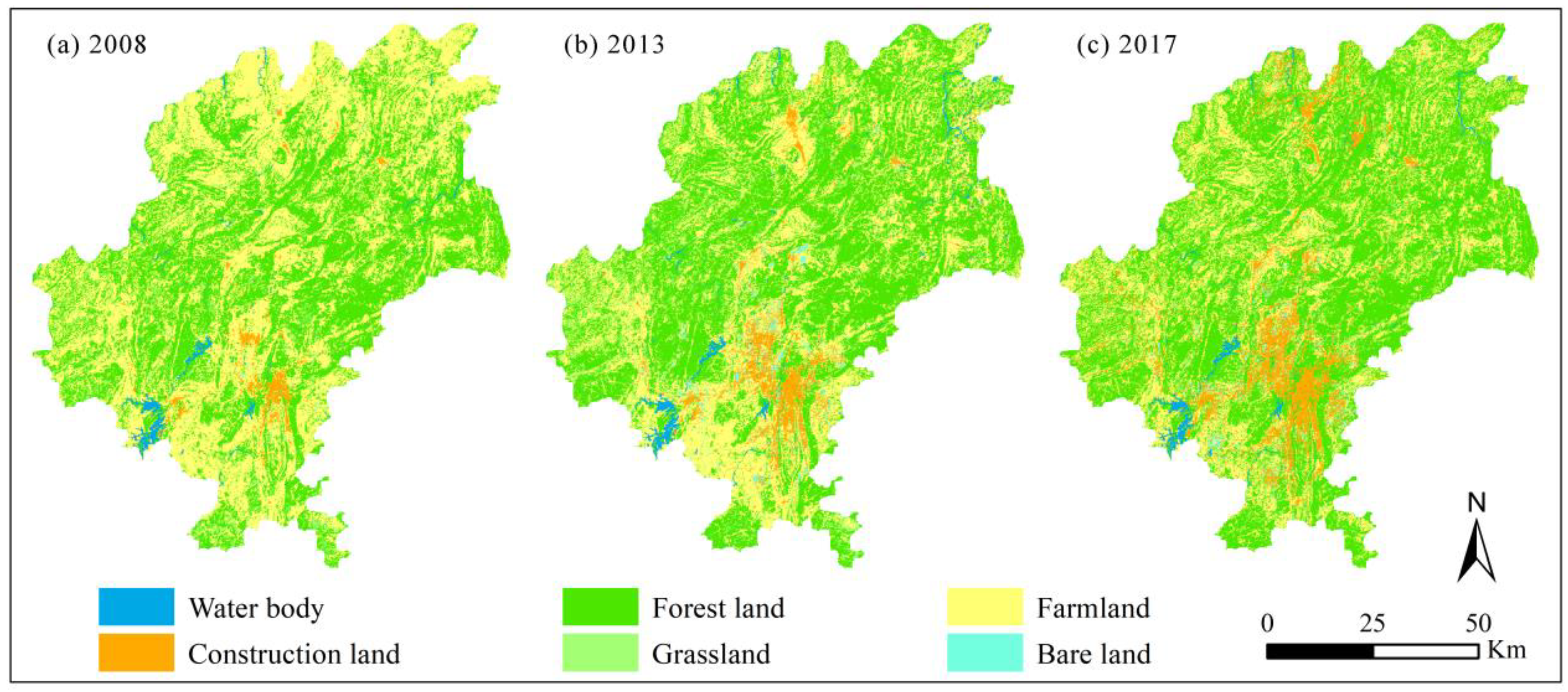

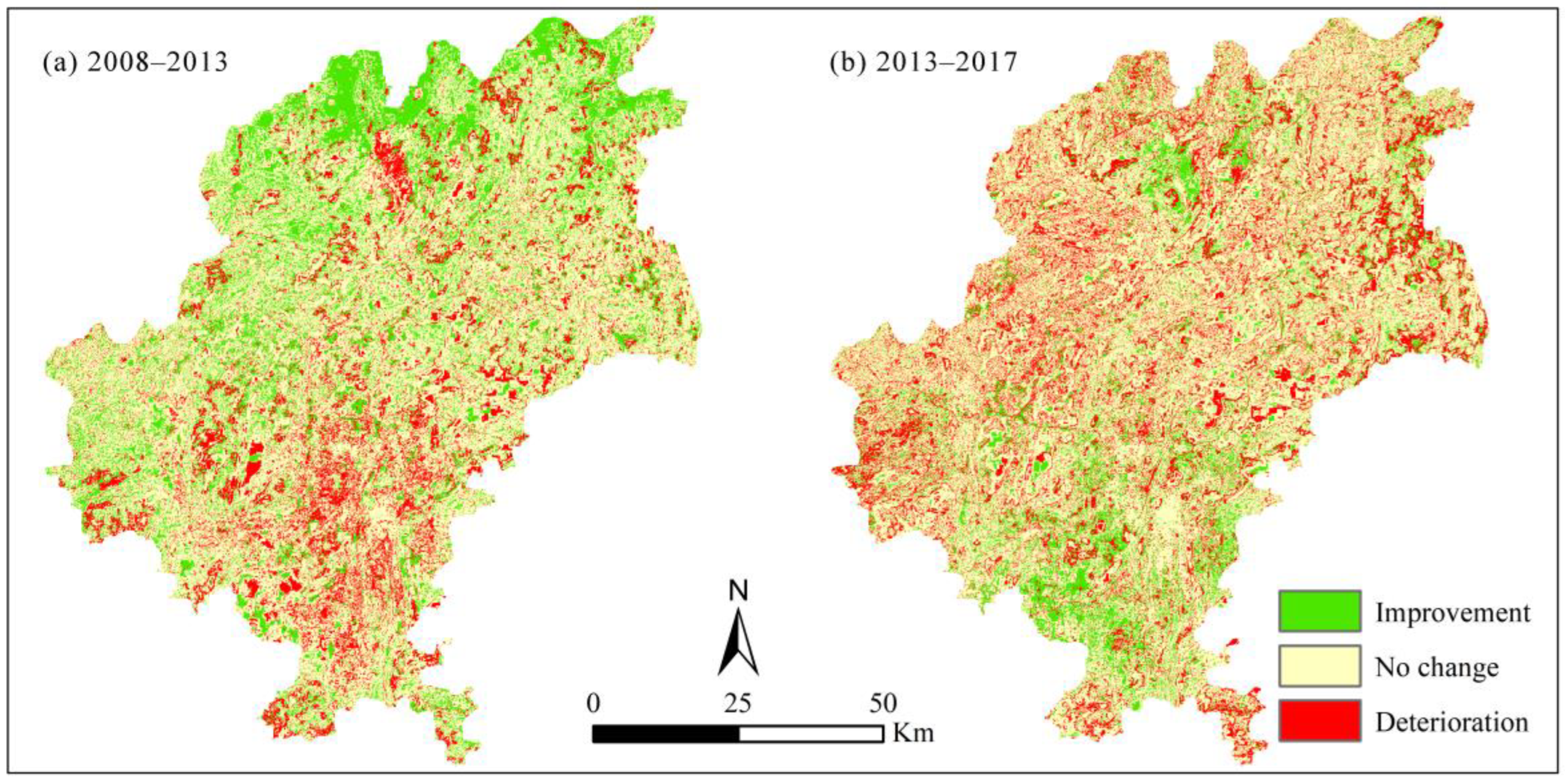
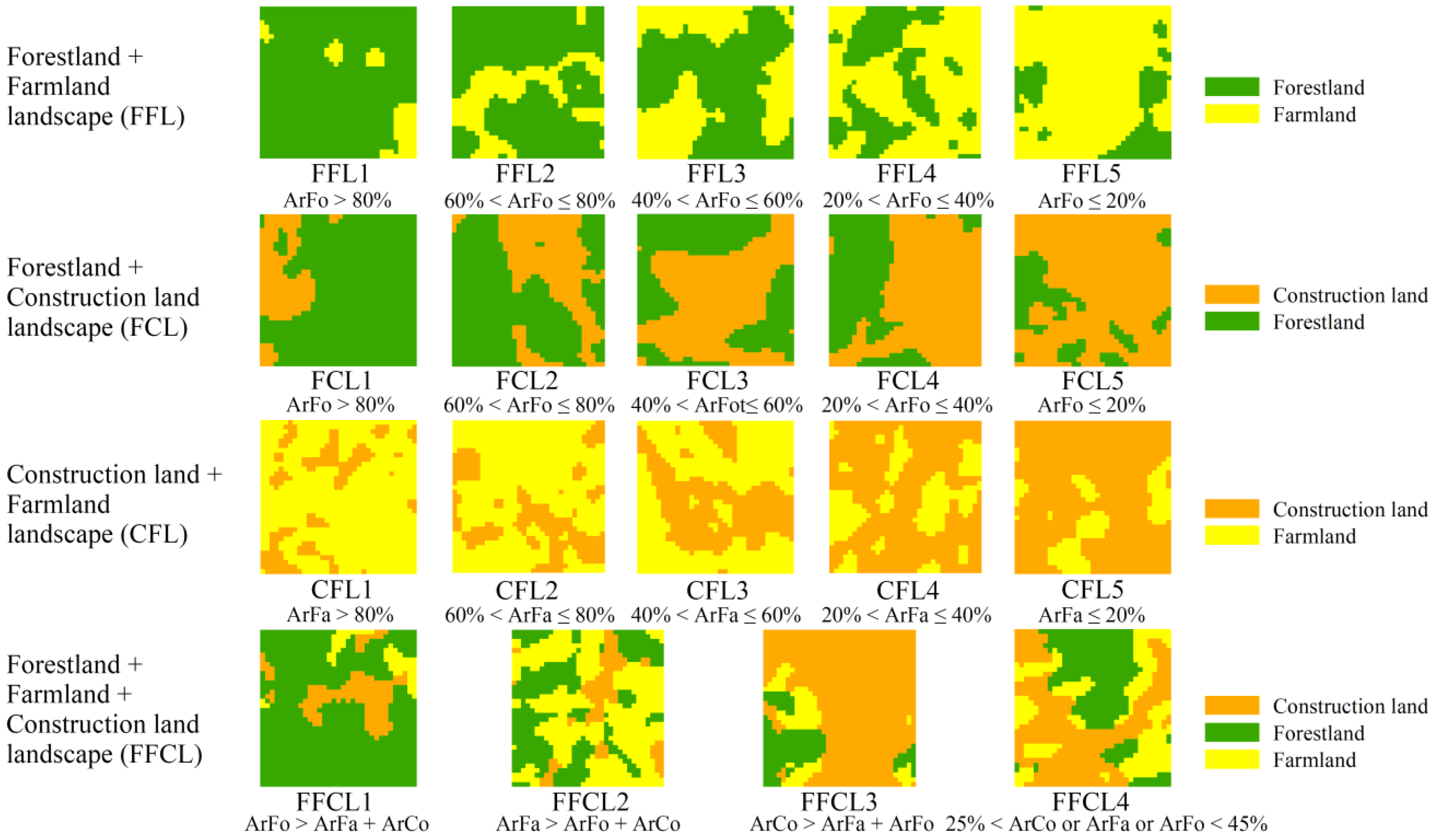
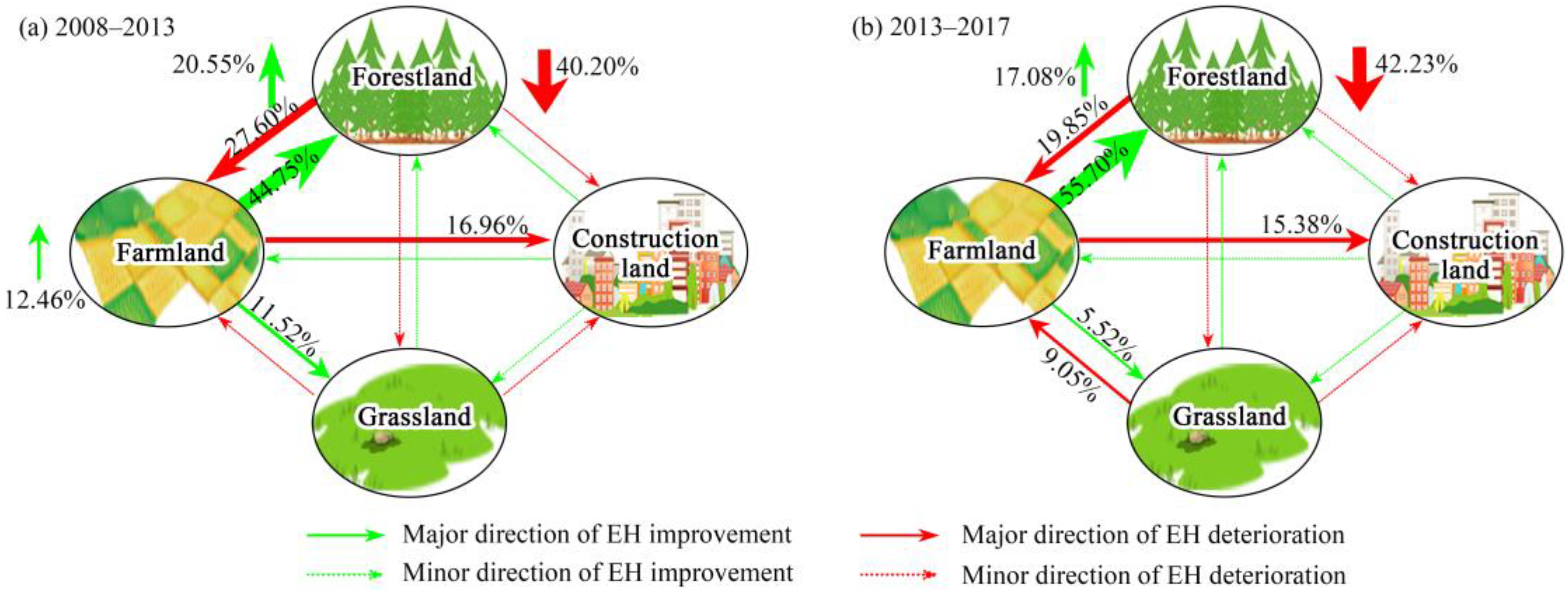
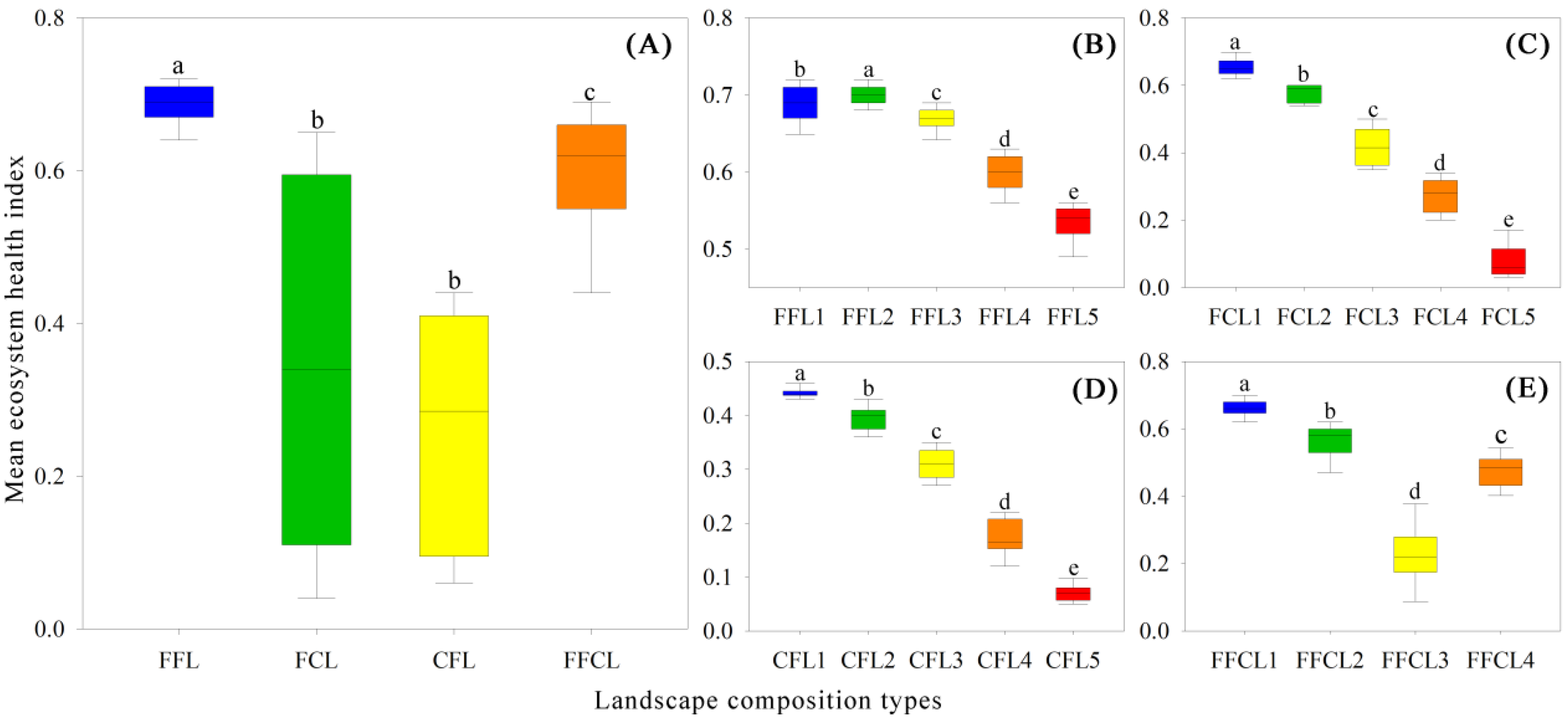
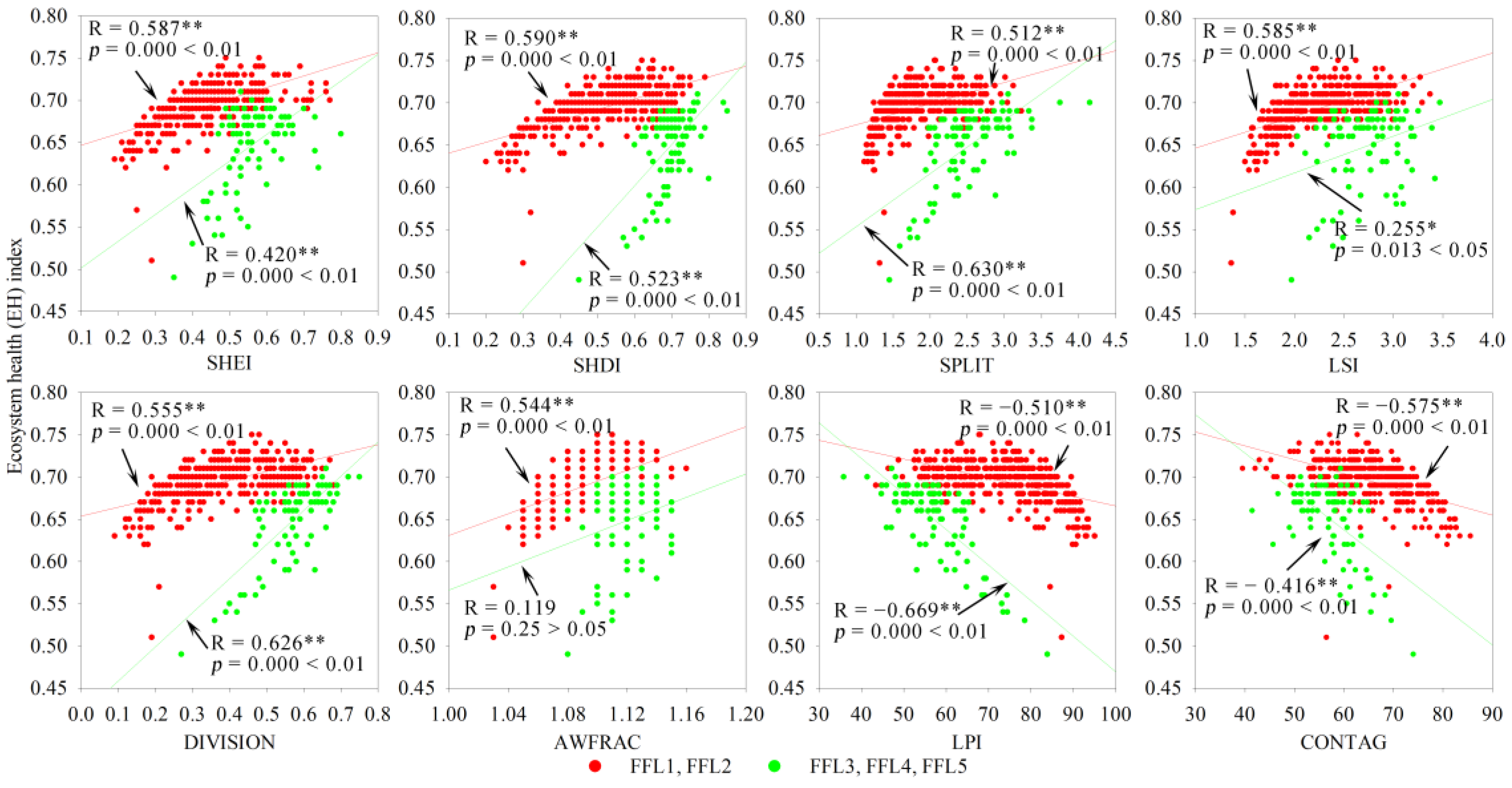
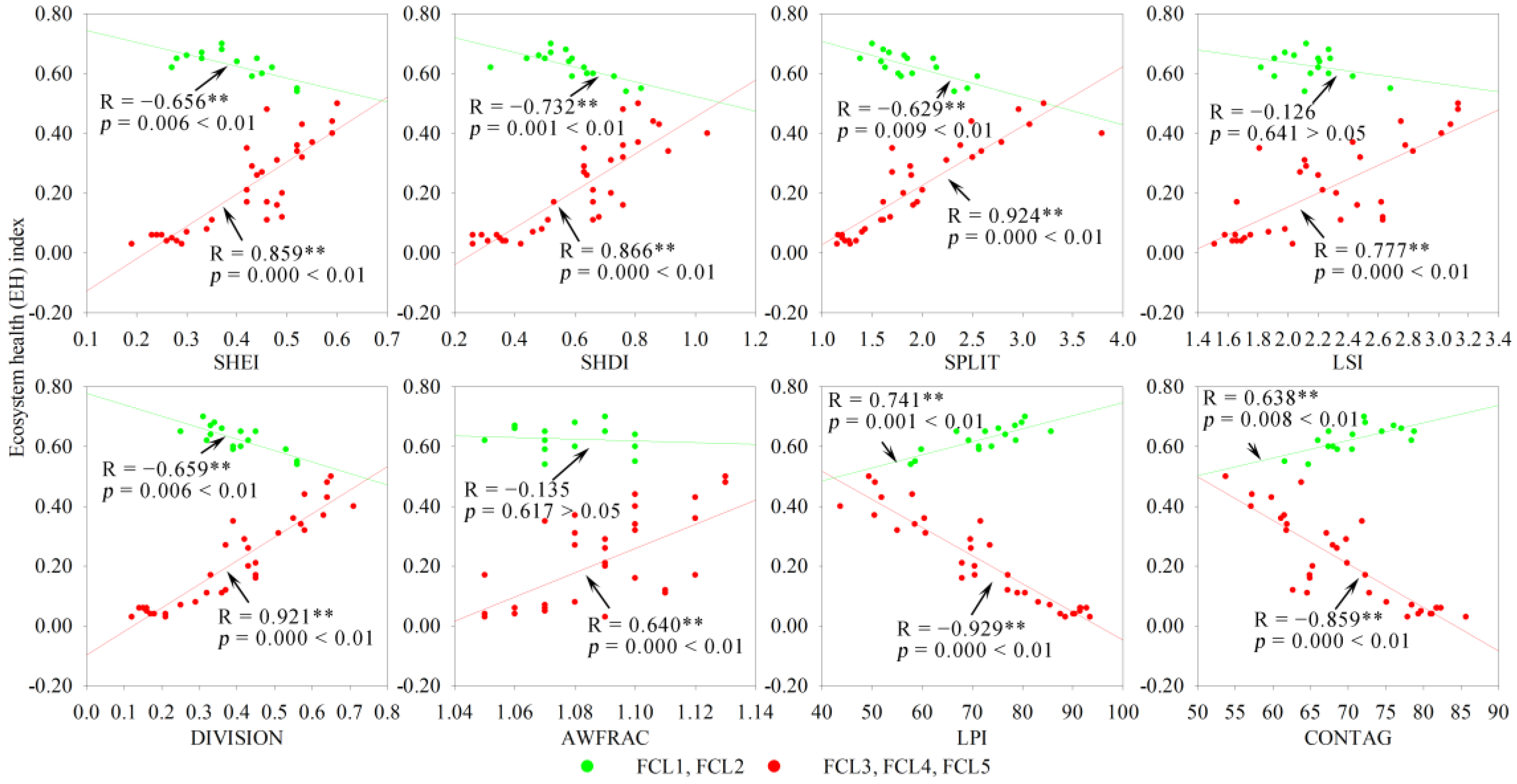

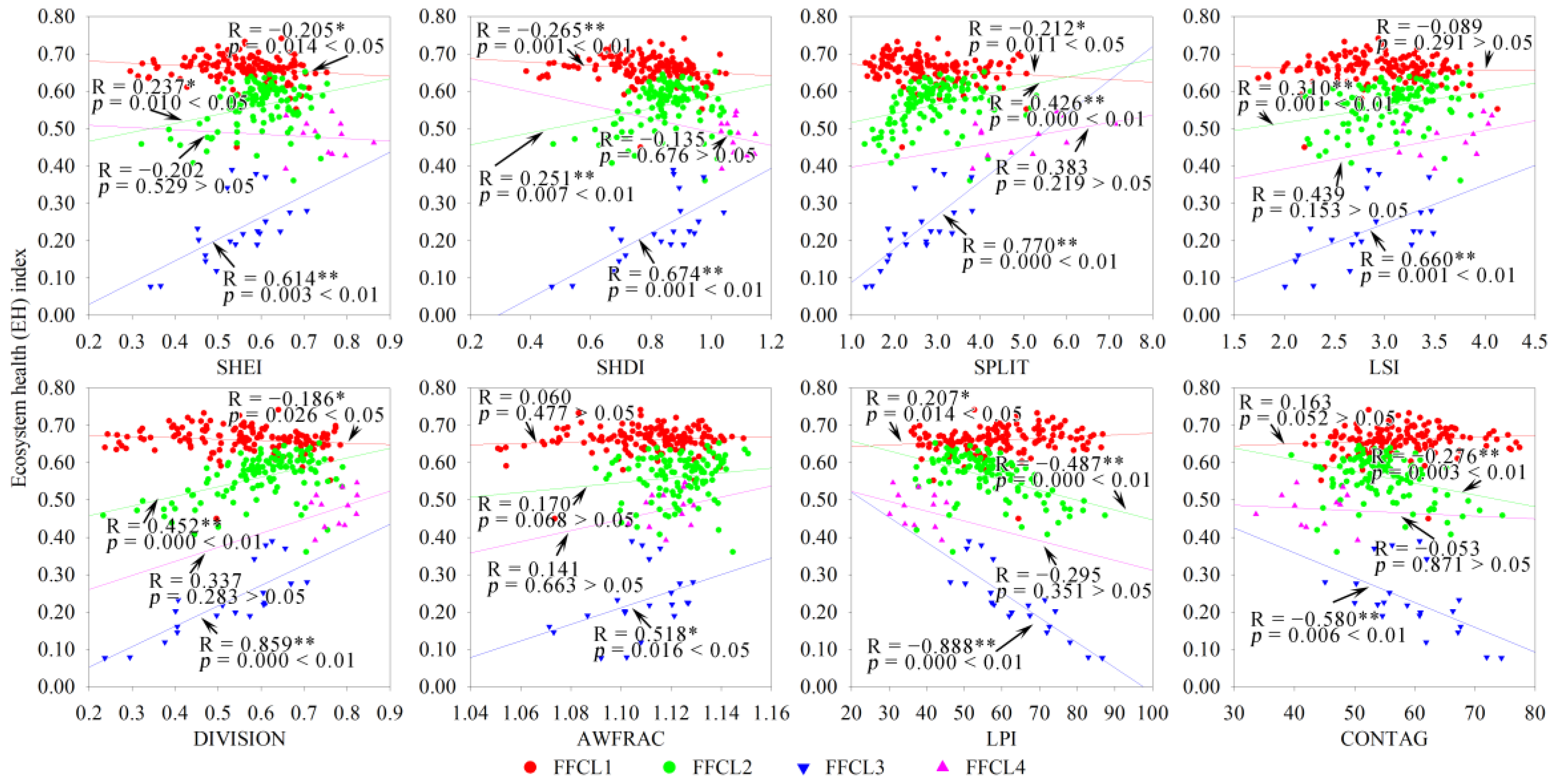
| Criterion Layer | LH | LC | LS | ||||
|---|---|---|---|---|---|---|---|
| LH | 1 | 1/4 | 1/7 | ||||
| LC | 4 | 1 | 1/2 | ||||
| LS | 7 | 2 | 1 | ||||
| Wic | 0.7153 | 0.187 | 0.0977 | ||||
| CR | 0.0019 | ||||||
| sub-index layer | SHDI | SHEI | COHESION | CONTAG | DIVISION | MNPARA | AWMFDI |
| SHDI | 1 | 1/2 | |||||
| SHEI | 2 | 1 | |||||
| COHESION | 1 | 4 | 2 | ||||
| CONTAG | 1/4 | 1 | 1/3 | ||||
| DIVISION | 1/2 | 3 | 1 | ||||
| MNPARA | 1 | 5 | |||||
| AWMFDI | 1/5 | 1 | |||||
| Wis | 0.6667 | 0.3333 | 0.1365 | 0.6250 | 0.2385 | 0.1667 | 0.8333 |
| CR | 0.0000 | 0.0176 | 0.0000 | ||||
| Wii | 0.4769 | 0.2384 | 0.0255 | 0.1169 | 0.0446 | 0.0814 | 0.0163 |
| Landscape Type | Forestland | Grassland | Farmland | Construction Land | Water Body | Bare Land |
|---|---|---|---|---|---|---|
| Resis | 1.0 | 0.6 | 0.5 | 0.3 | 0.8 | 0.2 |
| Resil | 0.6 | 0.8 | 0.3 | 0.2 | 0.7 | 1.0 |
| R | 0.84 | 0.68 | 0.42 | 0.26 | 0.76 | 0.52 |
| Land Use Types | 2008 | 2013 | 2017 | Change in Land Use (%) | |||||
|---|---|---|---|---|---|---|---|---|---|
| Area (km2) | Ratio (%) | Area (km2) | Ratio (%) | Area (km2) | Ratio (%) | 2008–2013 | 2013–2017 | 2008–2017 | |
| Farmland | 3703.08 | 48.51 | 2763.64 | 36.20 | 2297.61 | 30.10 | −25.37 | −16.86 | −37.95 |
| Forestland | 3426.42 | 44.88 | 3959.30 | 51.86 | 4285.26 | 56.13 | 15.55 | 8.23 | 25.07 |
| Grassland | 260.95 | 3.42 | 290.53 | 3.81 | 130.39 | 1.71 | 11.34 | −55.12 | −50.03 |
| Construction land | 137.83 | 1.81 | 368.37 | 4.83 | 704.04 | 9.22 | 167.27 | 91.12 | 410.82 |
| Water body | 92.57 | 1.21 | 155.61 | 2.04 | 97.17 | 1.27 | 68.10 | −37.55 | 4.97 |
| Bare land | 13.48 | 0.18 | 96.87 | 1.27 | 119.85 | 1.57 | 618.69 | 23.72 | 789.18 |
| Ecosystem Health Level | 2008 | 2013 | 2017 | |||
|---|---|---|---|---|---|---|
| Area (km2) | Ratio (%) | Area (km2) | Ratio (%) | Area (km2) | Ratio (%) | |
| Weak | 240.14 | 3.15 | 411.72 | 5.39 | 750.17 | 9.83 |
| Relatively weak | 250.49 | 3.28 | 52.73 | 0.69 | 3.61 | 0.05 |
| Ordinary | 3467.53 | 45.42 | 2901.20 | 38.01 | 2486.02 | 32.58 |
| Relatively strong | 1558.71 | 20.42 | 1739.67 | 22.79 | 2236.21 | 29.30 |
| Strong | 2117.45 | 27.74 | 2527.38 | 33.11 | 2155.52 | 28.24 |
Publisher’s Note: MDPI stays neutral with regard to jurisdictional claims in published maps and institutional affiliations. |
© 2022 by the authors. Licensee MDPI, Basel, Switzerland. This article is an open access article distributed under the terms and conditions of the Creative Commons Attribution (CC BY) license (https://creativecommons.org/licenses/by/4.0/).
Share and Cite
Wang, Z.; Liu, Y.; Li, Y.; Su, Y. Response of Ecosystem Health to Land Use Changes and Landscape Patterns in the Karst Mountainous Regions of Southwest China. Int. J. Environ. Res. Public Health 2022, 19, 3273. https://doi.org/10.3390/ijerph19063273
Wang Z, Liu Y, Li Y, Su Y. Response of Ecosystem Health to Land Use Changes and Landscape Patterns in the Karst Mountainous Regions of Southwest China. International Journal of Environmental Research and Public Health. 2022; 19(6):3273. https://doi.org/10.3390/ijerph19063273
Chicago/Turabian StyleWang, Zhijie, Yan Liu, Yixin Li, and Yuan Su. 2022. "Response of Ecosystem Health to Land Use Changes and Landscape Patterns in the Karst Mountainous Regions of Southwest China" International Journal of Environmental Research and Public Health 19, no. 6: 3273. https://doi.org/10.3390/ijerph19063273
APA StyleWang, Z., Liu, Y., Li, Y., & Su, Y. (2022). Response of Ecosystem Health to Land Use Changes and Landscape Patterns in the Karst Mountainous Regions of Southwest China. International Journal of Environmental Research and Public Health, 19(6), 3273. https://doi.org/10.3390/ijerph19063273






